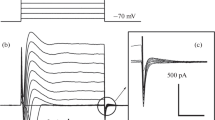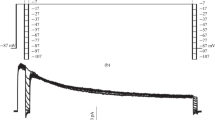Abstract
Previous studies have shown that the resting potential (E m) of the corneal endothelium hyperpolarizes following an increase in temperature above 24°C. Whole-cell studies using the perforated-patch technique were used to compare currents and E mvalues from isolated corneal endothelial cells at 24 and 32°C. These studies revealed a small, outwardly rectifying, slowly activating, weakly voltage-dependent current with a reversal potential showing K+ selectivity (E rev = −80 mV). This current had features similar to the whole-cell current seen following addition of HCO3 − to these cells. E mmeasurements found an average 24 mV hyperpolarization following temperature elevation in NaCl Ringer. Single channel studies found the only change in channel activity following an elevation in temperature to be an increase in the open probability (P o) of a K+ channel previously reported in this cell type to be activated by external anions. P o(−30 mV) at 24 and 32°C equaled 0.003 and 0.06, respectively. Increases in P owere found at all voltages examined. This increased P ocan account for the magnitude of the hyperpolarization seen in these cells following temperature elevation. Addition of HCO3 − along with elevated temperature produced a synergistic effect on the increase in P oalong with an increased hyperpolarization of the cell, pointing to separate mechanisms of activation from these two stimuli.
Similar content being viewed by others
References
Colquhoun, D., Hawkes, A.G. 1983. The principles of stochastic interpretation of ion-channel mechanisms. In: Single-Channel Recording. B. Sakmann and E. Neher, editors. pp. 135–175. Plenum, New York
Dikstein, S. 1973. Efficiency and survival of the corneal endothelial pump. Exp. Eye Res. 15:639–644
Dikstein S., Maurice, D.M. 1972. The active control of corneal hydration. Israel J. Med. Sci. 8:1523–1528
Doughty, M.J. 1989. Evidence for a direct effect of bicarbonate on the rabbit corneal stroma. Optometry Vis. Sci. 68:687–698
Hodson, S. 1971. Evidence for a bicarbonate-dependent sodium pump in corneal endothelium. Exp. Eye Res. 11:20–29
Jumblatt, M.M. 1981. Intracellular potentials of cultured rabbit corneal endothelial cells: Response to temperature and ouabain. Vision Res. 21:45–47
Liebovitch, L.S., Fischbarg, J. 1982, 1983. Effect of inhibitors of passive Na+ and HCO3 − fluxes on electrical potential and transport across rabbit corneal endothelium. Curr. Eye Res. 2:183–186
Lim, J. 1982, 1983. Effects of bicarbonate on the potential difference across the rabbit corneal endothelium. Curr. Eye Res. 2:529–535
MacInnes, D.A. 1961. Liquid junction potentials. In: The Principles of Electrochemistry, pp. 220–245. Dover Publications, New York
Mapstone, R. 1968. Measurement of corneal temperature. Exp. Eye Res. 7:237–243.
Rae, J.L., Cooper, K., Gates, P., Watsky, M.A. 1991. Low access resistance perforated patch recordings using amphotericin B. J. Neurosci. Methods 37:15–26
Rae, J.L., Dewey, J., Cooper, K. 1989. Properties of single potassium-selective ionic channels from the apical membrane of rabbit corneal endothelium. Exp. Eye Res. 49:591–609
Rae, J.L., Dewey, J., Cooper, K., Gates, P. 1990a. Potassium channel in rabbit corneal endothelium activated by external anions. J. Membrane Biol. 114:29–36
Rae, J.L., Dewey, J. Cooper, K., Gates, P. 1990b. A nonselective cation channel in rabbit corneal endothelium activated by internal calcium an inhibited by internal ATP. Exp. Eye Res. 50:373–384
Rae, J.L., Levis, R.A., Eisenberg, R.S. 1988. Ionic channels in ocular epithelia. In: Ion Channels. T. Narahashi, editor. pp. 283–327. Plenum, New York
Riley, M.V. 1983. The chemistry of the aqueous humor. In: Biochemistry of the Eye. R.E. Anderson, editor. pp. 79–95. American Academy of Ophthalmology, San Francisco
Watsky, M.A., Cooper, K., Rae, J.L. 1991. Sodium channels in ocular epithelia. Pfluegers Arch. 419:454–459
Watsky, M.A., Cooper, K., Rae, J.L. 1992. Transient outwardly rectifying potassium channel in the rabbit corneal endothelium. J. Membrane Biol. 128:123–132
Watsky, M.A., Rae, J.L. 1991. Resting voltage measurements of the rabbit corneal endothelium using patch-current clamp techniques. Invest. Ophthalmol. Vis. Sci. 32:106–111
Wigham, C., Hodson, S. 1981. The effect of bicarbonate ion concentration on trans-endothelial short circuit current in ox corneas. Curr. Eye Res. 1:37–44
Winkler, B.S., Riley, M.V., Peters, M.I., Williams, F.J. 1992. Chloride is required for fluid transport by the rabbit corneal endothelium. Am. J. Physiol. 262:C1167-C1174
Author information
Authors and Affiliations
Additional information
The authors would like to thank Ms. Helen Hendrickson for her technical support and Drs. Gianrico Farrugia and Adam Rich for their helpful comments. This work was supported by NIH grants EY09673, EY03282, EY06005, and an unrestricted award from Research to Prevent Blindness.
Rights and permissions
About this article
Cite this article
Watsky, M.A., Rae, J.L. Ion channel involvement in the temperature-sensitive response of the rabbit corneal endothelial cell resting membrane potential. J. Membarin Biol. 135, 61–71 (1993). https://doi.org/10.1007/BF00234652
Received:
Revised:
Issue Date:
DOI: https://doi.org/10.1007/BF00234652




